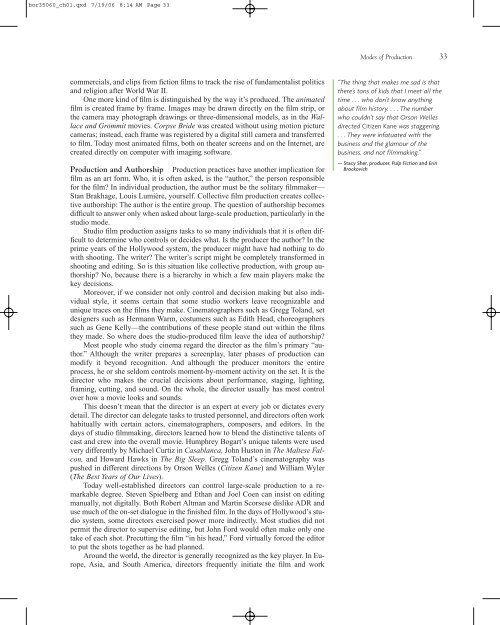FILM ART AND FILMMAKING
FILM ART AND FILMMAKING
FILM ART AND FILMMAKING
You also want an ePaper? Increase the reach of your titles
YUMPU automatically turns print PDFs into web optimized ePapers that Google loves.
or35060_ch01.qxd 7/19/06 8:14 AM Page 33<br />
commercials, and clips from fiction films to track the rise of fundamentalist politics<br />
and religion after World War II.<br />
One more kind of film is distinguished by the way it’s produced. The animated<br />
film is created frame by frame. Images may be drawn directly on the film strip, or<br />
the camera may photograph drawings or three-dimensional models, as in the Wallace<br />
and Grommit movies. Corpse Bride was created without using motion picture<br />
cameras; instead, each frame was registered by a digital still camera and transferred<br />
to film. Today most animated films, both on theater screens and on the Internet, are<br />
created directly on computer with imaging software.<br />
Production and Authorship Production practices have another implication for<br />
film as an art form. Who, it is often asked, is the “author,” the person responsible<br />
for the film? In individual production, the author must be the solitary filmmaker—<br />
Stan Brakhage, Louis Lumière, yourself. Collective film production creates collective<br />
authorship: The author is the entire group. The question of authorship becomes<br />
difficult to answer only when asked about large-scale production, particularly in the<br />
studio mode.<br />
Studio film production assigns tasks to so many individuals that it is often difficult<br />
to determine who controls or decides what. Is the producer the author? In the<br />
prime years of the Hollywood system, the producer might have had nothing to do<br />
with shooting. The writer? The writer’s script might be completely transformed in<br />
shooting and editing. So is this situation like collective production, with group authorship?<br />
No, because there is a hierarchy in which a few main players make the<br />
key decisions.<br />
Moreover, if we consider not only control and decision making but also individual<br />
style, it seems certain that some studio workers leave recognizable and<br />
unique traces on the films they make. Cinematographers such as Gregg Toland, set<br />
designers such as Hermann Warm, costumers such as Edith Head, choreographers<br />
such as Gene Kelly—the contributions of these people stand out within the films<br />
they made. So where does the studio-produced film leave the idea of authorship?<br />
Most people who study cinema regard the director as the film’s primary “author.”<br />
Although the writer prepares a screenplay, later phases of production can<br />
modify it beyond recognition. And although the producer monitors the entire<br />
process, he or she seldom controls moment-by-moment activity on the set. It is the<br />
director who makes the crucial decisions about performance, staging, lighting,<br />
framing, cutting, and sound. On the whole, the director usually has most control<br />
over how a movie looks and sounds.<br />
This doesn’t mean that the director is an expert at every job or dictates every<br />
detail. The director can delegate tasks to trusted personnel, and directors often work<br />
habitually with certain actors, cinematographers, composers, and editors. In the<br />
days of studio filmmaking, directors learned how to blend the distinctive talents of<br />
cast and crew into the overall movie. Humphrey Bogart’s unique talents were used<br />
very differently by Michael Curtiz in Casablanca, John Huston in The Maltese Falcon,<br />
and Howard Hawks in The Big Sleep. Gregg Toland’s cinematography was<br />
pushed in different directions by Orson Welles (Citizen Kane) and William Wyler<br />
(The Best Years of Our Lives).<br />
Today well-established directors can control large-scale production to a remarkable<br />
degree. Steven Spielberg and Ethan and Joel Coen can insist on editing<br />
manually, not digitally. Both Robert Altman and Martin Scorsese dislike ADR and<br />
use much of the on-set dialogue in the finished film. In the days of Hollywood’s studio<br />
system, some directors exercised power more indirectly. Most studios did not<br />
permit the director to supervise editing, but John Ford would often make only one<br />
take of each shot. Precutting the film “in his head,” Ford virtually forced the editor<br />
to put the shots together as he had planned.<br />
Around the world, the director is generally recognized as the key player. In Europe,<br />
Asia, and South America, directors frequently initiate the film and work<br />
Modes of Production 33<br />
“The thing that makes me sad is that<br />
there’s tons of kids that I meet all the<br />
time . . . who don’t know anything<br />
about film history. ... The number<br />
who couldn’t say that Orson Welles<br />
directed Citizen Kane was staggering.<br />
. . . They were infatuated with the<br />
business and the glamour of the<br />
business, and not filmmaking.”<br />
— Stacy Sher, producer, Pulp Fiction and Erin<br />
Brockovich

















